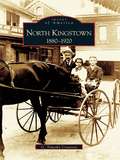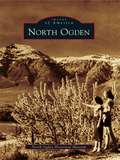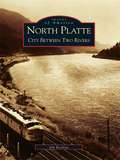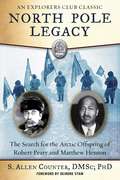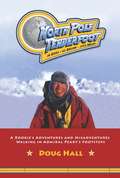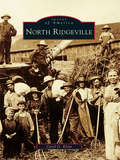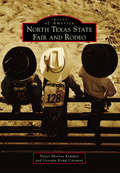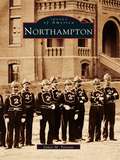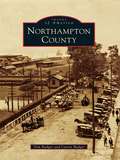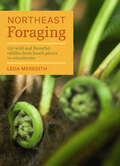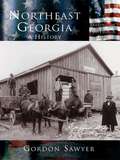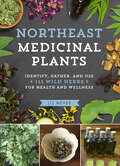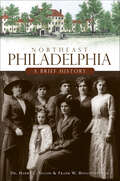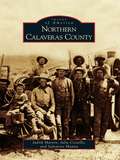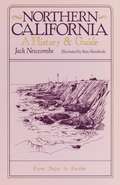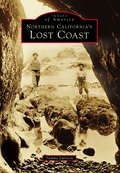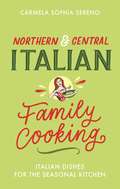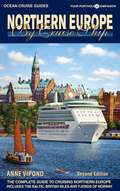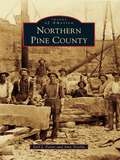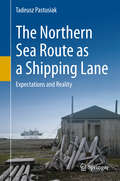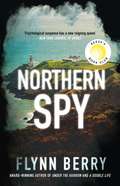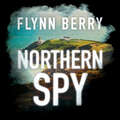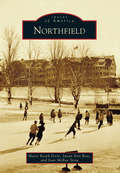- Table View
- List View
North Kingstown: 1880-1920
by G. Timothy CranstonIn the late 1880s, pharmacist Elwin "Doc" Young began to photograph the people, places, and events in his bustling crossroads community of North Kingstown. He turned the best of these images into postcards and sold them in hisapothecary shop. Today, readers can admire Young's impressive art in this volume, North Kingstown: 1880-1920. These pages highlight North Kingstown's golden era--a time when elite East Coast families on their way to Newportwould stop in quaint villages and mingle with the residents. These captivating images show the people, technology, and architecture of an important city at the beginning of the20th century.
North Ogden
by North Ogden Historical MuseumNorth Ogden is a quiet community nestled in the foothills of the Wasatch Mountains. The majestic Ben Lomond Peak silently towers over the city to the north with Lewis Peak standing guard to the east. Beautiful panoramic scenery is enjoyed in all directions. During the early 19th century, the city and surrounding areas were inhabited by the Spanish and Native Americans and explored by trappers. North Ogden City was established in 1851, and the challenges facing the pioneer families were numerous. Settlers encountered hostile Native Americans, hungry wild animals, devastating grasshopper invasions, and extreme weather conditions, and the food supplies were often depleted. Regardless, the city's population thrived, and farms, orchards, and businesses prospered. The perseverance of those early settlers is linked to the rich heritage treasured by the citizens of today.
North Olmsted (Images of America)
by Dale ThomasNorth Olmsted's history began in 1815 with David Johnson Stearns of Vermont. Stearns was followed to the area by other pioneers from New England, and they established a settlement in the wilderness of southwestern Cuyahoga County. North Olmsted went from being an isolated farming community to a village in 1908 and then to a city in 1951. The stage was then set for it to rapidly grow into a thriving suburb in the last half of the 20th century. North Olmsted's rich heritage is illustrated in this book through historic photographs from the Olmsted Historical Society that highlight the city's residents, businesses, social centers, and schools.
North Platte: City Between Two Rivers
by Jim BeckiusSituated at the junction of the North Platte and South Platte rivers, North Platte has a long history as an important stopping point in the westward migration of from the days of the California gold rush to the building of the transcontinental railroad and beyond. The Oregon Trail to the gold rush followed the South Platte River, and the Mormon Trail followed the North Platte River. In 1866 the building of the Union Pacific railroad stopped at North Platte for the winter. The railroad brought the town of North Platte to life. In 1869 the Union Pacific built a huge depot and hotel which stood until destroyed by fire in 1915. It entertained many famous visitors including William F. Cody, George Armstrong Custer, Bat Masterson, and Teddy Roosevelt. Since the 1920s North Platte has grown considerably, helped by the transcontinental Lincoln Highway which still runs through town. North Platte also had the first lighted runway in the United States, used for the air mail planes of the 1920s.
North Pole Legacy: The Search for the Arctic Offspring of Robert Peary and Matthew Henson
by S. Allen Counter Deirdre StamNorth Pole Legacy tells the story of two men whose existence was for decades nothing more than a popular legend. But that rumor was finally verified in 1986 when author S. Allen Counter journeyed to northern Greenland, and met this pair of remarkable men.Counter had long been an admirer of Matthew A. Henson, the African-American explorer who accompanied Admiral Robert E. Peary to the North Pole twice in early twentieth century. While conducting professional research in Sweden, Counter became intrigued by talk of mixed-race Inuit living in an isolated region of Greenland. Unable to forget this rumor, Counter traveled to investigate several years later, venturing more than a thousand miles north of the Arctic Circle. There, in two tiny villages, Counter met Anaukaq Henson and Kali Peary, Amer-Inuit sons of the two explorers. Born only days apart in 1906, they had long been acknowledged by their communities as the sons of Matthew Henson and Robert Peary, but had never been in contact with any of their American relatives. As it was obvious that these two men longed to see the country of their fathers, Counter arranged for Anakukaq, Kali, and their families to travel to America to meet their families.North Pole Legacy describes the obstacles that Counter overcame to bring news of Anaukaq Henson and Kali Peary to the world, to bring them to the United States, and to facilitate a reunion with relatives that they had never known. At the same time, the narrative flashes back to the unique history of Matthew Henson and Robert Peary in their collaboration as explorers and addresses their somewhat controversial claim to have been the first people to reach the North Pole.Compelling, insightful, and impossible to forget, North Pole Legacy is a must read for every history buff and armchair explorer.
North Pole Tenderfoot
by Doug HallWhy would Doug Hall follow in Robert Peary's 1909 sled tracks to the North Pole, despite the grueling terrain and temperatures between 15 and 62 degrees below zero? His goal was to resurrect the spirit of Peary's journey in a world increasingly driven by instant gratification, short term business focus, and lack of sustained dedication to great causes. Peary succeeded where some 578 expeditions before him had failed. North Pole Tenderfoot is Doug's attempt to let the reader experience what is possible when one does what Peary did: think big.
North Ridgeville (Images of America)
by Carol G. KlearNorth Ridgeville took root when 17 men, mostly members of the Beebe and Terrell families, left Waterbury, Connecticut, traveled west to Ohio, and established the first permanent settlement on May 10, 1810. Ridgeville Township was organized in 1813, centered at State Routes 20 and 83, and by the mid-1800s welcomed many people of German and English descent. In 1829, due to frequent mail mix-ups with Ridgeville, a town near Dayton, the postmaster general requested that the post office be named North Ridgeville. What was once a small farming community began to grow and prosper, and by 1958, North Ridgeville was incorporated as a village; two years later it became a city. Today the population nears 30,000, and North Ridgeville is flourishing, thanks to the hard work, determination, and pride of its forefathers.
North Texas State Fair and Rodeo (Images of America)
by Nanci Monroe Kimmey Georgia Kemp CarawayThe predecessor to the North Texas State Fair and Rodeo was reported in the October 15, 1885, Denton Doings as consisting of horse races sponsored by the Denton County Fair and Blooded Stock Association (DCFBSA). The next mention was 1890, when the association stockholders had the opportunity to purchase shares of the fairgrounds, thus ending the fair until five years later. The DCFBSA was reorganized in 1895 to host a fair and horse race near North Texas Normal College. The next race was held in 1896, and the association was incorporated. The fair has operated continuously since except for the years during World War II. These early events evolved into one of the largest fairs and rodeos in Texas, drawing more than 150,000 fairgoers annually.
Northampton
by James M. ParsonsThe beauty of the Connecticut River Valley in Massachusetts has always left visitors groping for superlatives, and the town of Northampton--once dubbed "The Athens of the Connecticut Valley"--has lately experienced a renaissance. Interest in the city has only risen through the years, and an assessment of its prominence throughout history easily explains its consistent attraction. From its settling in 1654 to the present, Northampton has been a hotbed of activity, idealism, growth, and change. Walking the streets of Northampton at different times were revolutionaries like Daniel Shays, patriots like Joseph Hawley, religious visionaries like Jonathan Edwards, idealists like the members of the utopian community in Florence, and governors like Caleb Strong and future president Calvin Coolidge. Notables like Sojourner Truth, Alexander Graham Bell, and President Franklin Pierce came and left, but their influences have remained.
Northampton County (Images of America)
by Curtis Badger Tom BadgerShortly after European colonists landed at Jamestown in 1607, they established a settlement in Northampton County. Settlers caught fish and shellfish in the shallow bays and creeks along the seaside and bayside and distilled salt from seawater to help preserve this bounty through the winter. Since 1608, Northampton has provided food for Virginia and the world. Fishing, crabbing, and clam aquaculture today are still an important part of the economic backbone of Northampton, but Northampton has been best known in recent years for land-based food production. The sandy soils of Northampton have always been productive, but when the railroad was built in 1884, it gave growers a method of getting produce to markets in a timely manner. So Northampton's history and culture have centered around food--gathering it, producing it, and shipping it--and the photographs in Images of America: Northampton County document this legacy.
Northeast Foraging: 120 Wild and Flavorful Edibles from Beach Plums to Wineberries (Regional Foraging Series)
by Leda Meredith“An invaluable guide for the feast in the East.” —Hank Shaw, author of the James Beard Award–winning website Hunter Angler Gardener Cook The Northeast offers a veritable feast for foragers, and with Leda Meredith as your trusted guide you will learn how to safely find and identify an abundance of delicious wild plants. The plant profiles in Northeast Foraging include clear, color photographs, identification tips, guidance on how to ethically harvest, and suggestions for eating and preserving. A handy seasonal planner details which plants are available during every season. Thorough, comprehensive, and safe, this is a must-have for foragers in New York, Connecticut, Massachusetts, Maine, New Hampshire, Vermont, Pennsylvania, New Jersey, Delaware, and Rhode Island.
Northeast Georgia: A History (Making of America)
by Gordon SawyerIn the late eighteenth century, waves of intrepid settlers made their way down the Great Wagon Road into the virgin wilderness of Northeast Georgia to find new homes and opportunity for land and wealth. Against a dramatic mountainous backdrop, these pioneers carved out farms and small communities in perilous isolation and created an American experience vastly different from that of the plantation-style society established along Georgia's coast. Battling Creek and Cherokee warriors, government intervention, natural disasters, and a landscape not easily tamed, year after year, these men and women of Northeast Georgia stamped their self-reliance, their perseverance, and their industriousness upon generations to follow and upon the very geography they called home.In Northeast Georgia: A History, readers travel across several centuries of change, from the early American Indian tribes that once made this territory their hunting grounds to the present day, a time of unprecedented growth and expansion in both industry and population. Truly a world unto itself, Northeast Georgia has served as a haven and destination for all classes over the past two centuries: the bold gold miners of 1829, the stalwart sustenance farmers, the social elite enjoying fresh mountain air at the many summer resorts, a multitude of businessmen seeking opportunity in railroading, cotton, lumber, and poultry farming, and bootleggers finding the landscape convenient for clandestine whiskey-making and distribution. These stories and more provide insight into understanding a people and place unique in Georgia.
Northeast Medicinal Plants: Identify, Harvest, and Use 111 Wild Herbs for Health and Wellness
by Liz NevesWildcraft your way to wellness! In Northeast Medicinal Plants, Liz Neves is your trusted guide to finding, identifying, harvesting, and using 111 of the region&’s most powerful wild plants. You&’ll learn how to safely and ethically forage, and how to use wild plants in herbal medicines including teas, tinctures, and salves. Plant profiles include clear, color photographs, identification tips, medicinal uses and herbal preparations, and harvesting suggestions. Lists of what to forage for each season makes the guide useful year-round. Thorough, comprehensive, and safe, this is a must-have for foragers, naturalists, and herbalists in Connecticut, Maine, Massachusetts, New Hampshire, New Jersey, New York, Pennsylvania, Rhode Island, and Vermont.
Northeast Philadelphia: A Brief History (Brief History)
by Dr. Harry Silcox Frank W. HollingsworthNortheast Philadelphia chronicles this area's history of transformation, from scattered communities to an urban center.Before the Consolidation Act of 1854 more than tripled the former capital's population, Northeast Philadelphia was a scattered group of pastoral communities just beyond the city limits. Holmesburg, Somerton and other small villages initially struggled but ultimately triumphed in their transition from rural townships to a bustling urban center. Dr. Harry C. Silcox has collaborated with Frank W. Hollingsworth to chart this fascinating evolution, from the demise of the family farm to neighbors uniting on the homefront during World War II. With such lively characters as Mary Disston, the founding mother of Tacony, and tales of the local effort for suffrage, Silcox and Hollingsworth create a brilliant and affectionate portrait of Northeast Philadelphia.
Northern Calaveras County
by Judith Marvin Salvatore Manna Julia CostelloNorthern Calaveras County stretches eastward from the valley towns of Wallace and Jenny Lind, through the Campo Seco and Mokelumne Hill gold country, to the county seat in San Andreas and finally extends to the upcountry mining camps and logging settlements of West Point and Railroad Flat. Historically water and trails connected these diverse regions. The Mokelumne River and its tributaries--diverted into flumes and ditches--brought water to the river bars, mines, ranches, settlements, and towns and provided their lifeblood. Trails first followed Native American paths and then developed into stage roads, railroads, and state highways. These routes connected the valley to the mountains and carried pioneers seeking gold, water, timber, fertile land, and recreation to new lands and new lives.
Northern California: A History and Guide - From Napa to Eureka
by Jack Newcombe Stan SkandinskiA History and Guide -- From Napa to Eureka.From the Trade Paperback edition.
Northern California's Lost Coast (Images of America)
by Tammy DurstonThe Lost Coast is one of the last undeveloped stretches of the California coastline, with mountains that rise thousands of feet from the sea. Located approximately 200 miles north of San Francisco, this remote area of pristine beauty is comprised of jagged cliffs, rocky shorelines, and black sand beaches. It is the only significant stretch of California without a highway. Rich in natural resources, the area was once a haven for Native Americans such as the Coast Yuki, Sinkyone, Mattole, and the Wiyot. Now it is a secluded landscape with a few isolated towns surrounded by conservation areas. The famed Lost Coast Trail begins in northern Mendocino County in the Sinkyone Wilderness and continues up into Humboldt County and the King Range National Conservation Area. During the 1800s, the Lost Coast bustled with logging settlements and mill towns. After logging wound down, those towns disappeared, and only remnants of their existence remain. From Westport north to Ferndale, this book showcases historical photographs from libraries, historical societies, and residents.
Northern & Central Italian Family Cooking: Italian Dishes for the Seasonal Kitchen
by Carmela Sophia SerenoJoin Carmela Sereno on a culinary journey from the breath-taking dolomites as far south as Lazio and Abruzzo, taking in the delicious and decadent flavour of northern and central Italy.What sets the northern and central regions of Italy apart from the cucina povera style of the south is its staple ingredients. From polenta, rice, pasta, game and seafood, to the use of butter, cream and alpine cheeses, the northern and central regions are much richer in terms of the ingredients they use. The result is an outstanding final flavour.Carmela's passion for Italian food and drink culture is at the forefront of every recipe she creates. The recipes in her latest book include: · Tomino cheese wrapped with basil and slices of speck· Veal Milanese, classic osso bucco served with a delicate, saffron-infused risotto· Cappellacci stuffed with rabbit, pork and veal· Fontina fondue· Roman oxtail stew Whether an indulgent Friday night dinner or a quick weekday meal, the recipes in this book will please the whole family.
Northern & Central Italian Family Cooking: Italian Dishes for the Seasonal Kitchen
by Carmela Sophia SerenoJoin Carmela Sereno on a culinary journey from the breath-taking dolomites as far south as Lazio and Abruzzo, taking in the delicious and decadent flavour of northern and central Italy.What sets the northern and central regions of Italy apart from the cucina povera style of the south is its staple ingredients. From polenta, rice, pasta, game and seafood, to the use of butter, cream and alpine cheeses, the northern and central regions are much richer in terms of the ingredients they use. The result is an outstanding final flavour.Carmela's passion for Italian food and drink culture is at the forefront of every recipe she creates. The recipes in her latest book include: · Tomino cheese wrapped with basil and slices of speck· Veal Milanese, classic osso bucco served with a delicate, saffron-infused risotto· Cappellacci stuffed with rabbit, pork and veal· Fontina fondue· Roman oxtail stew Whether an indulgent Friday night dinner or a quick weekday meal, the recipes in this book will please the whole family.
Northern Europe By Cruise Ship - 2nd Edition: The Complete Guide to Cruising Northern Europe – includes Baltic, British Isles and Fjords of Norway
by Anne VipondEmbark on a voyage to some of the most famous capitals of the world with the new second edition of Northern Europe By Cruise Ship. From the British Isles to Scandinavia, Russia, the Baltic States and Germany, Northern Europe By Cruise covers the ports, shore excursions, cruise options and shopping opportunities. Also included is the history, culture and all the must see attractions of the countries of this fascinating cruise destination. Maps throughout show exactly where the ships dock and distances into town and city cores with detail on getting around on your own.
Northern Pine County
by Earl J. Foster Amy TroolinFeaturing over 210 historical photographs, Images of America: Northern Pine County guides readers on an exciting journey into the past as it explores the successes and sorrows as well as the joys and trials of the people of northern Pine County, Minnesota. Each chapter examines a unique aspect of their daily lives. Readers meet loggers and settlers from the county's earliest days, catch a glimpse of many towns and villages, and encounter a variety of industries, businesses, schools, and churches that shaped the area's economic and social landscapes. Life was not easy for the people who called northern Pine County home. On September 1, 1894, and again on October 12, 1918, forest fires devastated portions of the county, killing hundreds, destroying thousands of acres, and leaving countless residents homeless. While photographs cannot capture the heartache of fire victims, they do provide a window into northern Pine County's rich history and help tell the fascinating stories of its residents.
The Northern Sea Route as a Shipping Lane
by Tadeusz PastusiakThis book analyses the current and future viability of the Northern Sea Route as a stable transport route for the international transit traffic between Europe and the Far East. It includes the present conditions, defining and evaluating viability factors for using the Northern Sea Route (NSR). The book makes a projection for NSR in the future, taking into account the climatic change in the Arctic findings presented in the IPCC report. This study, based on the author's PhD thesis, analyses meteorological, hydrologic, bathymetric and other data for the evaluation of the navigation criteria. It is intended for a wide spectrum of readers, from students and scientists of Earth sciences and polar geography, navigation, political science researchers and politicians interested in Arctic affairs.
Northern Spy: A Reese Witherspoon's Book Club Pick
by Flynn BerryTHE INSTANT NEW YORK TIMES BESTSELLERA REESE'S BOOK CLUB PICK'You'll devour Northern Spy . . . I loved this thrill ride of a book'Reese Witherspoon'A sharp, moving thriller: you lose your breath for adrenalin'Abigail Dean, author of Girl A'An exciting thriller... A domestic noir with a difference'Adrian McKinty, author of The Chain'A chilling, gorgeously written tale'New York Times'Nerve-shredding suspense'Daily Mail'Thrillingly good... Flynn Berry shows a le Carré-like flair for making you wonder what's really going on at any given moment'Washington Post A producer at the Belfast bureau of the BBC, Tessa is at work one day when the news of another IRA raid comes on the air: as the anchor requests the public's help in locating those responsible for this latest attack - a robbery at a gas station - Tessa's sister Marian appears on the screen, pulling a black mask over her face.The police believe Marian has joined the IRA, but Tessa knows this is impossible. But when the truth of what has happened to her sister reveals itself, Tessa will be forced to choose: between her ideals and her family. Praise for Flynn Berry'Breathtaking . . . Berry writes thrillingly'New York Times'Beautifully paced and satisfyingly ominous'Guardian'Mesmerizingly effective'The Times 'A thrilling page-turner'Paula Hawkins, author of The Girl on the Train'Berry's clever, thrilling writing wound me in and left me heartbroken'Fiona Barton, author of The Widow'What a book! A skillful and compelling exploration of families, crime, and class'Clare Mackintosh, author of I Let You Go
Northern Spy: A Reese Witherspoon's Book Club Pick
by Flynn BerryTHE INSTANT NEW YORK TIMES BESTSELLER | A REESE'S BOOK CLUB PICK'You'll devour Northern Spy . . . I loved this thrill ride of a book'REESE WITHERSPOON'A chilling, gorgeously written tale... Berry is a beautiful writer with a sophisticated, nuanced understanding of this most complicated of places'NEW YORK TIMES'Thrillingly good... Flynn Berry shows a le Carré-like flair for making you wonder what's really going on at any given moment' WASHINGTON POST'An elegantly wrought story about the perils of not being what you seem... Nerve-shredding suspense'DAILY MAILA producer at the Belfast bureau of the BBC, Tessa is at work one day when the news of another IRA raid comes on the air. As the anchor requests the public's help in locating those responsible for this latest attack - a robbery at a gas station - Tessa's sister appears on the screen pulling a black mask over her face.The police believe Marian has joined the IRA, but Tessa knows this is impossible. But when the truth of what has happened to her sister reveals itself, Tessa will be forced to choose: between her ideals and her family.
Northfield (Images of America)
by Marie Booth Ferré Joan Mcrae Stoia Susan Post RossNorthfield's mountains, abundant forests, and rich agricultural fields along the Connecticut River sustained native inhabitants for centuries before the English settled in the area known as Squakheag in 1713. Incorporated in 1723, Northfield became a crossroads for travel and commerce, supporting ferries, taverns, mills, and other farm-related businesses. Elegant Federal-style homes crafted in the 1800s by the Stearns brothers still line the iconic Main Street. Northfield native Dwight L. Moody, a famous evangelist, founded area schools and summer conferences. In the late 19th century, the quiet farming town became "heaven on earth" to Moody's followers, who arrived by the hundreds each summer seeking spiritual renewal and relief from the cities. The railroad brought visitors to the first American youth hostel and to the popular Northfield Inn and Chateau, where many permanent residents found employment. Around Northfield, Queen Anne-style homes provided lodging for boarders, while tearooms, milliners, liveries, and grocers served visitors. Today, Northfield's vitality and spirit endures, forged by education, hard work, civic engagement, and perseverance.
